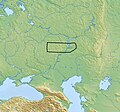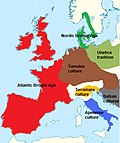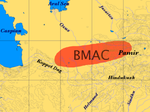culture, the Catacomb culture and the Poltavka culture. It is co-ordinate and probably closely related to the Andronovo culture, its eastern neighbor...
16 KB (1,630 words) - 04:49, 24 October 2024
Yamna. The Yamnaya culture was succeeded in its western range by the Catacomb culture (2800–2200 BC); in the east, by the Poltavka culture (2700–2100 BC)...
68 KB (7,012 words) - 14:21, 25 October 2024
and the Poltavka culture. The Catacomb culture was distributed on the Pontic steppe, an area that had earlier been occupied by the Yamnaya culture. This...
28 KB (3,353 words) - 14:11, 20 October 2024
. The tribes of the Abashevo culture appear in the forest-steppe zone, almost simultaneously with the Poltavka culture. The Abashevans are marked by...
63 KB (7,092 words) - 23:43, 31 October 2024
Bastida de Totana wall remains Map of El Argar Cist burial reconstruction El Argar Los Millares: its antecessor culture. Bell Beaker culture: its antecessor...
14 KB (1,412 words) - 10:42, 26 October 2024
Afanasievo culture, or Afanasevo culture (Afanasevan culture) (Russian: Афанасьевская культура Afanas'yevskaya kul'tura), is an early archaeological culture of...
62 KB (6,056 words) - 17:40, 20 October 2024
The Únětice culture, Aunjetitz culture or Unetician culture (Czech: Únětická kultura, German: Aunjetitzer Kultur, Polish: Kultura unietycka, Slovak: Únětická...
78 KB (8,270 words) - 21:08, 24 October 2024
The Bell Beaker culture, also known as the Bell Beaker complex or Bell Beaker phenomenon, is an archaeological culture named after the inverted-bell beaker...
165 KB (19,249 words) - 21:06, 24 October 2024
Kurgan hypothesis (redirect from Kurgan culture)
prehistoric cultures, including the Yamnaya (or Pit Grave) culture and its predecessors. In the 2000s, David Anthony instead used the core Yamnaya culture and...
34 KB (3,818 words) - 02:41, 26 August 2024
Sarmatians (redirect from Sarmatian culture)
to be closely related to peoples of the earlier Yamnaya culture and to the Poltavka culture. A genetic study published in Nature in May 2018 examined...
81 KB (8,705 words) - 19:32, 31 October 2024
The Urnfield culture (c. 1300–750 BC) was a late Bronze Age culture of Central Europe, often divided into several local cultures within a broader Urnfield...
104 KB (11,112 words) - 21:57, 2 October 2024
The Samara culture is an Eneolithic (Copper Age) culture dating to the turn of the 5th millennium BCE, at the Samara Bend of the Volga River (modern Russia)...
13 KB (1,337 words) - 19:17, 3 October 2024
The Globular Amphora culture (GAC, German: Kugelamphoren-Kultur (KAK); c. 3400–2800 BC, is an archaeological culture in Central Europe. Marija Gimbutas...
11 KB (1,250 words) - 12:44, 21 October 2024
The Polada culture (22nd to 16th centuries BCE) is the name for a culture of the ancient Bronze Age which spread primarily in the territory of modern-day...
11 KB (1,202 words) - 12:43, 18 June 2024
The Scythian culture was an Iron Age archaeological culture which flourished on the Pontic-Caspian steppe in Eastern Europe from about 700 BC to 200 AD...
95 KB (13,137 words) - 20:07, 13 October 2024
Celts (redirect from Ancient Celtic culture)
110–. Gimbutas, Marija (25 August 2011). Bronze Age cultures in Central and Eastern Europe. Walter de Gruyter. pp. 100–. ISBN 978-3-1116-6814-7. Milisauskas...
149 KB (16,673 words) - 00:22, 29 October 2024
Bronze Age. Corded Ware culture encompassed a vast area, from the contact zone between the Yamnaya culture and the Corded Ware culture in south Central Europe...
79 KB (9,108 words) - 03:41, 18 October 2024
The Armorican Tumulus culture is a Bronze Age culture, located in the western part of the Armorican peninsula of France. It is known through more than...
17 KB (1,746 words) - 00:18, 5 July 2024
The Apennine culture is a technology complex in central and southern Italy from the Italian Middle Bronze Age (15th–14th centuries BC). In the mid-20th...
10 KB (1,174 words) - 08:41, 18 March 2024
Indo-Aryans developed, are identified with the Sintashta culture (2100–1800 BCE), and the Andronovo culture,[citation needed] which flourished ca. 1800–1400 BCE...
20 KB (1,594 words) - 14:45, 23 October 2024
Cimmerians (redirect from Kimmerian culture)
other early nomadic cultures of the Eurasian steppe and forest steppe which existed before the 7th century BC, such as the Aržan culture, so that these various...
169 KB (20,507 words) - 02:58, 27 October 2024
The Glazkov culture, Glazkovo culture, or Glazkovskaya culture (2200-1200 BCE), was an archaeological culture in the Lake Baikal area during the Early...
13 KB (1,283 words) - 23:22, 4 April 2024
The Karasuk culture (Russian: Карасукская культура, romanized: Karasukskaya kul'tura) describes a group of late Bronze Age societies who ranged from the...
30 KB (3,313 words) - 22:15, 25 October 2024
The Dnieper–Donets culture complex (DDCC) (ca. 5th—4th millennium BC) is a Mesolithic and later Neolithic archaeological culture found north of the Black...
22 KB (2,306 words) - 10:02, 11 April 2024
Bronze Age in Romania (redirect from Verbicioara culture)
including the Baden-Coţofeni culture, the Cernavodă III-Belleraz culture, the Glina-Schneckenberg culture and the Verbicioara culture. Common occupations were...
8 KB (719 words) - 07:19, 26 October 2024
Patroni, C. A. De Cara. Gli scavi di Anzola Wikimedia Commons has media related to Terramare culture. Mallory, J.P. (1997). "Terramare Culture". Encyclopedia...
17 KB (1,874 words) - 13:12, 1 November 2024
Las Cogotas (category Archaeological cultures of Europe)
Tolmos de Caracena in Soria, Cogeces del Monte in Valladolid, Abia de la Obispalia in Cuenca, and some others, allow to describe Protocogotas culture as a...
11 KB (753 words) - 08:44, 30 October 2024
the Origins of Vedic Culture: The Indo-Aryan Migration Debate. Oxford University Press. ISBN 0-19-516947-6. CNRS, L'archéologie de la Bactriane ancienne...
59 KB (6,960 words) - 22:14, 28 August 2024
Proto-Indo-Europeans (category Neolithic cultures)
north of Europe (Corded Ware culture), the edges of Central Asia (Yamnaya culture), and southern Siberia (Afanasievo culture). In the words of philologist...
54 KB (6,411 words) - 09:32, 18 September 2024
Gaels (redirect from Gaelic culture)
languages comprising Irish, Manx and Scottish Gaelic. Gaelic language and culture originated in Ireland, extending to Dál Riata in western Scotland. In antiquity...
94 KB (10,096 words) - 20:24, 22 October 2024























